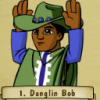Game designers comunicate in a multitude of ways and it differs from company to company.
Most games companies nowadays try to (or pretend to) follow some kind of Agile development process. One of the key principles of Agile production is that the most effective means of communication is a face to face conversation. In SCRUMM there are plenty of chances for the designer to communicate with the rest of the team in a face to face or virtual manner (story planning, story pointing, daily standup, end of sprint demo, retrospective).
Its worth pointing out that in Agile there should never be a separation of concerns. Unfortunately this is one of the areas that most teams screw up on. There should not be an "I'm done chuck it over the fence to the next team" mentality. i.e..
Design team -> Dev Team -> QA = wrong way of working
It is supposed to be the whole team communicating together and working together so designers, devs and QA may frequently be sat around the same machine (or screen sharing on virtual teams) tweaking stuff and working things out. Ideally there should be no such thing as a design team,, programming team etc.. There should just be a team of people with different skills working on a task together.
Other methods of communication will include software tools such as Flowdock, Slack or Trello which basically are fancy chat rooms that plug into all the other tools that are used in a development studio.
One thing designers love to use to communicate things is post it notes. A lot of designers I have worked with are obsessed with writing down every single idea they have and leaving them stuck everywhere.













